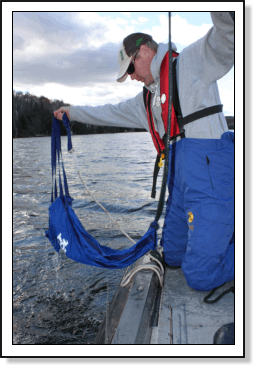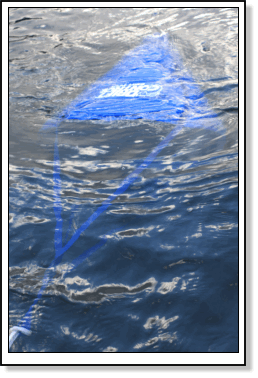Sock it to the Fish
By
Justin Hoffman (
Click
here to visit my new website!)
Weather conditions are a fact of life for
those that choose to wet a line. From
pounding rain to sauna-like heat – and
everything in between – we stoically stare
down Mother Nature when there are fish
waiting to be caught. But give us wind and
we curse its existence – all while blowing
mercilessly amongst the waves with each gust
it rains down on us.
But there is hope. The light at the end of
the wind tunnel is an essential and
functional angling tool called the drift
sock – a wind and wave tamer that too few
anglers use, but a “day saver” item that
should be stock on each and every boat that
plies the water.
What To Buy?
When purchasing a drift sock, the rule of
thumb is to buy one to match the length of
boat you run. This will give you a ballpark
size to begin your search with, which can
then be fine-tuned to the perfect fit
dependent on what severity of wind
conditions you routinely face.
Many drifting applications call for the use
of two socks, so choose one sock that
matches your boat specifications and another
the next size up. This will cover a variety
of bases while allowing you to experiment
and see which methods work best.

Tricks of the Trade
 Drifting Flats
Drifting Flats – Working expansive flats
when the wind is howling can make for a
tough day of fishing, especially if pitching
jigs to walleye or tossing spoons to
northern pike. In order to slow down your
approach, while keeping a controlled drift,
you will want to utilize two drift socks on
the windward side of the boat. Attach a
larger sock to a cleat just below the bow
and a smaller sock at the rear on either the
port or starboard side – depending on which
direction the wind is blowing.
Deploying the drift socks in this
configuration will alleviate any issues with
uneven boat drifting, and with the outboard
motor also creating drag, will allow you to
slowly pick apart a flat and fish it
effectively and thoroughly. Any minor
positioning changes can be achieved with the
bow mount motor, or with the transom
electric, kicker or big engine.
Windblown Shorelines – Nothing rings the
dinner bell more loudly to a predatory fish
than a windblown shoreline does. This is
exceptionally true with walleye, smallmouth
bass, and muskie. Trying to fan cast
effectively, without being pushed up on
shore, can often be an exercise in
frustration – especially when the winds are
gusting strongly. To combat this problem, a
drift sock should be attached to the rear
corner of the windblown side. With this
configuration, your boat will remain
parallel to the shoreline, and the bow mount
trolling motor will be used to inch your way
along the drift and periodically nose the
bow out and away from the shore.
Backtrolling Precision – Fishing breaklines
or working humps requires controlled
rigging. This is best achieved by
backtrolling your offering directly and
slowly in front of the fish. When winds are
high and waves rough, however, the ability
to keep the bow from swinging and
overcompensating motor movements is often a
reality. To combat this occurrence, tie a
drift sock directly off the bow of the boat
and backtroll with the wind. This will help
you regain total control of your spinner rig
or crank – and hopefully the walleye bite.

If speed becomes an issue, choose a larger
drift sock or shift your motor in and out of
neutral when needed.
Big Motor Trolling – Although most
applications for a drift sock revolve around
wind, trollers are also seeing the merit in
this device. They are especially useful for
those anglers that don’t have a kicker or
electric motor, and are forced to use the
big outboard.
In order to slow down “too fast” trolling
speeds, tie off two “smallish” drift socks
to each side of the boat – approximately at
the mid-way point. Shorten the tow rope
lengths so as to alleviate the chance of
tangles in the prop.
Tying One On
An integral part of the drift sock system is
the tow rope and dump line. As the name
suggests, the tow rope is attached to the
main harness of the sock. Tying off to a
cleat on the boat is then done with the
loose end. By using a length of rope (two to
eight-feet) variances can be made for
certain applications, and the drift sock
itself can always be kept out and away from
the boat.
Pulling a drift sock back into the boat when
fully inflated and submerged can be a tough
deal – and an exercise in brute strength. A
dump line makes life easier.
Attached to the tail end of the sock (and
the boat cleat or tow rope), a tug on this
retrieval line will swing the smallest end
forward, collapsing the sock and allowing it
to be pulled easily and effortlessly on
board. A key rule to keep in mind is to
ensure that your dump line is longer than
the overall length of the tow rope and drift
sock.